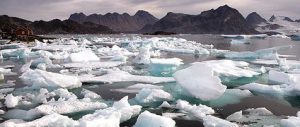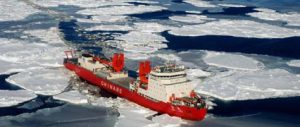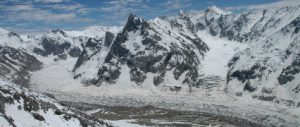New shipping lanes allow bulk carriers to move straight across the top of the world, cutting transport emissions by nearly half. Through these lanes, travel oil, gas and minerals that disappearing ice has made available for extraction. Smelters along the coast of Greenland process the minerals, using low-emissions hydroelectric power from the massive outflows of melting glaciers.
Welcome to the coming “sustainable development” of the Arctic.
The Arctic is a region in flux, and its changing geography commands increasing attention from global policymakers, scientists and, not least, industry. The disappearance of vast areas of sea ice in the past decade – maximum sea ice extent this year was 1.2 million square kilometres below the 1979 to 2000 average – is opening up offshore areas along the continental shelf for resource exploitation. Remote locations are becoming easier to explore. By the middle of the century, some models predict, the Arctic may be entirely ice-free during summer months.
Legally, too, there is renewed interest. The areas of ocean once covered with ice are largely governed by the laws of territorial states and the United Nations Convention on the Law of the Sea but as their perceived significance increases, governance questions are being raised and reviewed.
The Arctic nations – Norway, Russia, the United States, Canada and Greenland – in partnership with the world’s major industries are selling the exploitation of riches at the top of the world as an opportunity that advancing economies and a growing population cannot resist. They are building the needed infrastructure now that will allow for the full exploitation of the remote region, which includes land areas near the coast, the whole of Greenland and, perhaps most importantly, the ocean with its lucrative continental shelf. (See Linda Jakobson’s three-part article on chinadialogue, “Preparing for an ice-free Arctic” for a detailed view on Arctic development and China’s interest in the region’s changing geography.)
But as they set out on the task of industrialising the last frontier, political and industrial leaders are under pressure to explain the dubious nature of their enterprise: profiting from and exacerbating the ongoing environmental disaster they say they want to stop. Development of the region represents a serious political risk for the nations moving to exploit their shares in it, as it directly counters the international process on climate change, which is meant to halt dangerous interference with the climate system.
The disappearance in recent years of ice cover of an area about the size of Alaska in the Arctic Ocean is seen by scientists as a key indicator that greenhouse-gas emissions are approaching levels that may dangerously interfere with the climate system, triggering a series of harmful changes that would be impossible to repair in near-term timescales. This is the level of warming that all the Arctic nations have pledged to take action to prevent under the United Nations Framework Convention on Climate Change.
Norwegian foreign minister Jonas Gahr Støre recently took a crack at explaining how a leader in the international effort to limit greenhouse-gas emissions has also recently opened up new areas of the Arctic Ocean to oil and gas extraction, a move that promises to maintain Norway’s status as a top oil and gas producer for decades to come.
“Yes, it is a paradox. But it is not only Norway’s paradox, it is the world’s paradox,” he told the crowd at the Arctic Frontiers conference in Tromsø, Norway, in January, an annual convention organised by a committee of researchers and industry figures which aims to be a leading forum on the future development of the Arctic. “If Norway were to say that our contribution to this is to end oil and gas exploration, the limited effect of that would be a quite significant increase of coal and oil, not an immediate transfer to wind or waves . . . If we as an energy player were to play the card that the best contribution we could make is to drop out of the world economy, it would not make a contribution.”
Støre said Norwegians will “use our experience from our energy age to promote renewables”. But such proclamations do not blunt the reality that progress on limiting carbon dioxide has stalled, while actions to bolster the future of the oil and gas industry are moving rapidly ahead.
The contradiction is all the more stark given that most scientists are stressing it is not too late to slow emissions in order to avoid reaching the rapidly approaching points of no return, but time is short. Reductions on the order of 3% to 4% per year, starting in the next couple of years, are necessary. Arctic warming could also be significantly slowed in the near term through the reduction of pollutants like black carbon and ozone.
“On the one hand, they claim to be concerned, but on the other hand the opportunities they seek involve making the problem worse,” Carlos Duarte, a leading scholar in the rapidly growing field of ecosystem thresholds with the Mediterranean Institute for Advanced Studies, told chinadialogue at the forum in Tromsø.
“When politicians are confronted with this paradox, all they have to say is that even though they are aware that this behaviour is in conflict, they cannot take unilateral action to move their economies away from a carbon-based economy. But somebody has to break through this loop, because the road that this loop is taking us is not a pleasant one,” Duarte said.
The road ahead
Picture the top of the world as the first domino in long line of dominoes that make up the climate system, a region whose properties can hold the earth system in check, or change suddenly and tip off a series of rapid and irreversible changes.
Scientists have identified 14 thresholds of climatic change in the earth system, and six are concentrated in the Arctic, according to Duarte, making it of central global importance to maintaining the climate system. Based mainly on the massive loss of sea ice, Duarte said: “We are very close to seeing a tipping point in the Arctic.”
But countries are choosing to ignore their pledges to stop dangerous climate change and are instead utilising the climate changes in the Arctic as an opportunity to “mobilise more fossil fuels”, Duarte said.
Russia and Greenland are already counting on the economic gains from exploiting vast mineral deposits in the Arctic region. Southern Greenland is expected to contain one of the world’s largest undeveloped deposits of rare-earth elements, which are used in advanced technology applications, particularly related to clean energy, such as electric car batteries and engines, wind turbines and solar panels. China is the world’s dominant supplier but has recently cut back on its exports, a move that is driving the search for other sources. In December 2010, mineral exploration company Greenland Minerals and Energy secured a permit to evaluate deposits of rare earth elements, uranium and zinc, with plans to start production in 2015.
The northern parts of Russia are also set for the expansion of mining for gold, iron ore, tin and phosphate, altogether worth an estimated US$2 trillion (13 trillion yuan). The world has historically relied on extractive industries in Russia and other northern areas for minerals, and increased access to shipping lanes and rising global demand is expected to push the industry to new heights.
“Mineral extraction is a key part of the economic strategies of the northern countries for the coming years,” said Morten Smelror, director general of the Geological Survey of Norway.
Rear admiral David Titley, oceanographer of the United States Navy, is not focused on figuring out how to preserve landscapes and habitat, or rapidly reduce greenhouse-gas emissions. His job as director of the Navy’s Task Force Climate Change is to bring together big players “who have billions of dollars at stake” in the future of the Arctic – like the multinational retailer Walmart – to run through scenarios concerning a future Arctic shipping environment.
What they have found is that an ice-free ocean at the North Pole “could look like the Gulf of Mexico on steroids”, Titley said. “There are three rivers, each the size and scope of the United States’ Mississippi River flowing into here [from Russia]. Shallow shelf, rich in resources.”
The admiral was implying that the Arctic holds much more potential for production than the Gulf of Mexico, which hosts an estimated 4,000 active offshore oil and gas drilling platforms and 27,000 abandoned wells.
High prices for commodities are key drivers of Arctic development, as well as the projected increase in energy demand over the coming decades. The US Energy Information Administration estimates that emerging economies, driven largely by China and India, will see energy use rise by 118% between 2007 and 2035.
The plans for Arctic development universally make assurances of strict environmental protection of the region. “We put a lot of emphasis on sustainability issues. We also have some of the best performing smelters in the world, in terms of environmental performance,” said Ronny Vatland of Alcoa, an aluminium producer which has plans to launch heavy industry in Greenland and already operates in Iceland.
But even as the economic development plans move ahead, frameworks and regulations to ensure environmental protection are not in place. Intergovernmental forums like the Arctic Council and the International Maritime Organization are working to establish such frameworks, though there is concern that the rules may not be in place soon enough given the rapidly advancing development.
But amid the excitement over the Arctic’s potential, there are voices calling for caution, among them Aqqaluk Lynge of the Inuit Circumpolar Council, who is urging restraint in plans for development until adequate assurances can be made for the environment and for the 2 million indigenous people who live traditional lifestyles here. “There is an inadequate environmental assessment process,” Lynge said. “We are concerned with the pace of development and the rush to resources.” He added that many native groups fear a “boom and bust economy” that tears apart their ancient cultures.
What impact these opposing interests will have on the industrial development under way in the Arctic is yet to be seen. Few are watching the remote region, and the Arctic countries have already demonstrated that they are making the choice to develop the area rather than preserve it, despite international commitments to the contrary. The break with commitments to the UNFCCC could undercut the overall effort on greenhouse-gas reductions, and may bode ill for other stated commitments to sustainable development.
Jenny Johnson is a journalist based in St Petersburg, Russia.
Homepage image from Patrick Kelley, US Coast Guard


